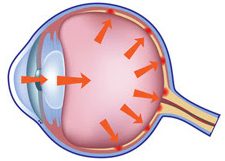Elevated Eye Pressure
Ocular Hypertension (OHT) occurs when the pressure inside the eye, known as intraocular pressure (IOP), is higher than normal. While high IOP is a hallmark of glaucoma, OHT itself is not glaucoma. In OHT, the optic nerve remains healthy, and there are no signs of vision loss, which differentiates it from glaucoma. However, elevated IOP is a significant risk factor for developing glaucoma, so monitoring and managing OHT is essential.
How OHT and Glaucoma Differ
In glaucoma, the optic nerve is progressively damaged by elevated IOP or, in some cases, even normal IOP. This nerve damage can lead to irreversible vision loss if untreated. In OHT, high eye pressure exists without optic nerve damage or loss of vision. Individuals with OHT do not automatically have glaucoma, but the condition puts them at a higher risk, and their IOP needs to be managed to prevent progression to glaucoma.

Risks and Factors Contributing to OHT
Several factors contribute to the development of ocular hypertension. Genetics play a significant role, with individuals having a family history of OHT or glaucoma being at increased risk. Age is another factor, as IOP tends to increase over time. Additionally, ethnicity may impact risk, with people of African descent showing a higher predisposition to both OHT and glaucoma.
Lifestyle factors also influence OHT. Excessive caffeine intake, high blood pressure, and long-term use of steroid medications can all contribute to elevated IOP. For individuals with multiple risk factors, regular eye exams are essential to monitor eye pressure and prevent the potential progression to glaucoma.
Prevention and Detection
While OHT is not glaucoma, it is a critical warning sign. Early detection and regular monitoring can help manage IOP levels, reducing the risk of developing glaucoma and preserving long-term vision. Consult an eye care professional if you have risk factors to stay proactive about your eye health.


